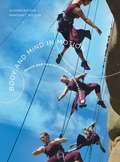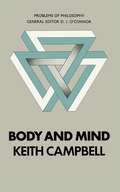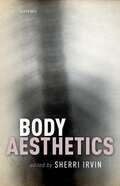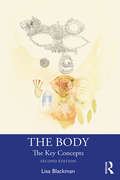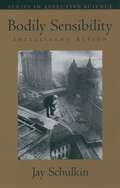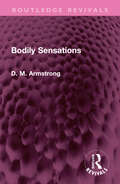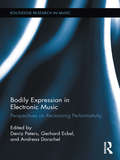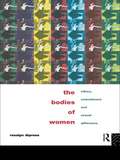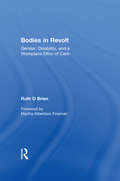- Table View
- List View
Body and Practice in Kant (Studies in German Idealism #6)
by Helge SvareKant is generally conceived to have offered little attention to the fact that we experience the world in and through our bodies. This book argues that this standard image of the great German philosopher is radically wrong. Not only does Kant - throughout his career and in works published before and after the Critique of pure reason - reflect constantly upon the fact that human life is embodied, but the Critique of pure reason itself may be read as a critical reflection aimed at exploring some significant philosophical implications of this fact. Bringing this aspect of Kant's philosophy into focus is important, not only because it sheds new light on our understanding of Kant's work, but also because it is relevant to contemporary discussions in philosophy about embodiment, learning and practice. By taking his philosophy of embodiment into account, the author makes Kant stand out as a true contemporary in new and unexpected ways.
Body and Mind in Motion: Dance and Neuroscience in Conversation (PDF)
by Glenna Batson Margaret WilsonDrawing from the burgeoning field of 'embodiment' – itself an idea at the intersection of the sciences, humanities, arts and technologies – Body and Mind in Motion highlights the relevance of somatic education within dance education, dance science and body-mind studies.
Body-and Image-Space: Re-Reading Walter Benjamin (Warwick Studies in European Philosophy)
by Sigrid WeigelThe last decade has seen a new wave of interest in philosophical and theoretical circles in the writings of Walter Benjamin. In Body-and Image-Space Sigrid Weigel, one of Germany's leading feminist theorists and a renowned commentator on the work of Walter Benjamin, argues that the reception of his work has so far overlooked a crucial aspect of his thought - his use of images. Weigel shows that it is precisely his practice of thinking in images that holds the key to understanding the full complexity, richness and topicality of Benjamin's theory.
Body-and Image-Space: Re-Reading Walter Benjamin (Warwick Studies in European Philosophy)
by Sigrid WeigelThe last decade has seen a new wave of interest in philosophical and theoretical circles in the writings of Walter Benjamin. In Body-and Image-Space Sigrid Weigel, one of Germany's leading feminist theorists and a renowned commentator on the work of Walter Benjamin, argues that the reception of his work has so far overlooked a crucial aspect of his thought - his use of images. Weigel shows that it is precisely his practice of thinking in images that holds the key to understanding the full complexity, richness and topicality of Benjamin's theory.
Body and Gender, Soul and Reason in Late Antiquity
by Gillian ClarkWhat does it mean to say that a human being is body and soul, and how does each affect the other? Late antique philosophers, Christians included, asked these central questions. The papers collected here explore their answers, and use those answers to ask further questions, reading Iamblichus, Porphyry, Augustine and others in their social and intellectual context. Among the topics dealt with are the following. Humans are mortal rational beings, so how does the mortal body affect the rational soul? The body needs food: what foods are best for the soul, and is it right to eat animal foods if animals are less rational than humans? The body is gendered for reproduction: are reason and the soul also gendered? Ascetic lifestyles may free our bodies from the limitations of gender and desire, so that our souls are free to reconnect with the divine; but this need must be balanced with the claims of family and society. Philosophers asked whether life in the body is exile for the soul; Christians defended their claim that body as well as soul would live after death, and even the smallest fragment of a martyr's body is proof of resurrection.
Body and Gender, Soul and Reason in Late Antiquity
by Gillian ClarkWhat does it mean to say that a human being is body and soul, and how does each affect the other? Late antique philosophers, Christians included, asked these central questions. The papers collected here explore their answers, and use those answers to ask further questions, reading Iamblichus, Porphyry, Augustine and others in their social and intellectual context. Among the topics dealt with are the following. Humans are mortal rational beings, so how does the mortal body affect the rational soul? The body needs food: what foods are best for the soul, and is it right to eat animal foods if animals are less rational than humans? The body is gendered for reproduction: are reason and the soul also gendered? Ascetic lifestyles may free our bodies from the limitations of gender and desire, so that our souls are free to reconnect with the divine; but this need must be balanced with the claims of family and society. Philosophers asked whether life in the body is exile for the soul; Christians defended their claim that body as well as soul would live after death, and even the smallest fragment of a martyr's body is proof of resurrection.
Body Aesthetics (PDF)
by Sherri IrvinThe body is a rich object for aesthetic inquiry. We aesthetically assess both our own bodies and those of others, and our felt bodily experiences-as we eat, have sex, and engage in other everyday activities-have aesthetic qualities. The body, whether depicted or actively performing, features centrally in aesthetic experiences of visual art, theatre, dance and sports. Body aesthetics can be a source of delight for both the subject and the object of the gaze. But aesthetic consideration of bodies also raises acute ethical questions: the body is deeply intertwined with one's identity and sense of self, and aesthetic assessment of bodies can perpetuate oppression based on race, gender identity, sexual orientation, age, size, and disability. Artistic and media representations shape how we see and engage with bodies, with consequences both personal and political. This volume contains sixteen original essays by contributors in philosophy, sociology, dance, disability theory, critical race studies, feminist theory, medicine, and law. Contributors take on bodily beauty, sexual attractiveness, the role of images in power relations, the distinct aesthetics of disabled bodies, the construction of national identity, the creation of compassion through bodily presence, the role of bodily style in moral comportment, and the somatic aesthetics of racialized police violence.
Body Aesthetics
by Sherri IrvinThe body is a rich object for aesthetic inquiry. We aesthetically assess both our own bodies and those of others, and our felt bodily experiences-as we eat, have sex, and engage in other everyday activities-have aesthetic qualities. The body, whether depicted or actively performing, features centrally in aesthetic experiences of visual art, theatre, dance and sports. Body aesthetics can be a source of delight for both the subject and the object of the gaze. But aesthetic consideration of bodies also raises acute ethical questions: the body is deeply intertwined with one's identity and sense of self, and aesthetic assessment of bodies can perpetuate oppression based on race, gender identity, sexual orientation, age, size, and disability. Artistic and media representations shape how we see and engage with bodies, with consequences both personal and political. This volume contains sixteen original essays by contributors in philosophy, sociology, dance, disability theory, critical race studies, feminist theory, medicine, and law. Contributors take on bodily beauty, sexual attractiveness, the role of images in power relations, the distinct aesthetics of disabled bodies, the construction of national identity, the creation of compassion through bodily presence, the role of bodily style in moral comportment, and the somatic aesthetics of racialized police violence.
Body Aesthetics
The body is a rich object for aesthetic inquiry. We aesthetically assess both our own bodies and those of others, and our felt bodily experiences—as we eat, have sex, and engage in other everyday activities—have aesthetic qualities. The body, whether depicted or actively performing, features centrally in aesthetic experiences of visual art, theatre, dance and sports. Body aesthetics can be a source of delight for both the subject and the object of the gaze. But aesthetic consideration of bodies also raises acute ethical questions: the body is deeply intertwined with one's identity and sense of self, and aesthetic assessment of bodies can perpetuate oppression based on race, gender identity, sexual orientation, age, size, and disability. Artistic and media representations shape how we see and engage with bodies, with consequences both personal and political. This volume contains sixteen original essays by contributors in philosophy, sociology, dance, disability theory, critical race studies, feminist theory, medicine, and law. Contributors take on bodily beauty, sexual attractiveness, the role of images in power relations, the distinct aesthetics of disabled bodies, the construction of national identity, the creation of compassion through bodily presence, the role of bodily style in moral comportment, and the somatic aesthetics of racialized police violence.
The Body: The Key Concepts
by Lisa BlackmanThoroughly updated and revised throughout with brand new chapters on affective bodies, indeterminate bodies, assemblaged bodies and a new conclusion, and featuring essay and classroom questions for classroom use, The Body: Key Concepts, Second Edition, presents a concise and up-to-date introduction to, and analysis of, the complex and influential debates around the body in contemporary culture. Lisa Blackman outlines and illuminates those debates which have made the body central to current interdisciplinary thinking across the arts, humanities and sciences. Since body studies hit the mainstream, it has grown in new regions, including China, and moved in new directions to question what counts as a body and what it means to have and be a body in different contexts, milieu and settings. Lisa Blackman guides the reader through socio-cultural questions around representation, performance, class, race, gender, disability and sexuality to examine how current thinking about the body has developed and been transformed. Blackman engages with classic anthropological scholarship from Nancy Scheper-Hughes and Margaret Lock, revisits black feminist writings from the 1980s, as well as engaging with recent debates, thought and theorists who are inventing new concepts, methods and ways of apprehending embodiment which challenge binary and dualistic categories. It provides an overview of the proliferation of body studies into other disciplines, including media and cultural studies, philosophy, gender studies and anthropology, as well as mapping the future of body studies at the intersections of body and affect studies.
The Body: The Key Concepts
by Lisa BlackmanThoroughly updated and revised throughout with brand new chapters on affective bodies, indeterminate bodies, assemblaged bodies and a new conclusion, and featuring essay and classroom questions for classroom use, The Body: Key Concepts, Second Edition, presents a concise and up-to-date introduction to, and analysis of, the complex and influential debates around the body in contemporary culture. Lisa Blackman outlines and illuminates those debates which have made the body central to current interdisciplinary thinking across the arts, humanities and sciences. Since body studies hit the mainstream, it has grown in new regions, including China, and moved in new directions to question what counts as a body and what it means to have and be a body in different contexts, milieu and settings. Lisa Blackman guides the reader through socio-cultural questions around representation, performance, class, race, gender, disability and sexuality to examine how current thinking about the body has developed and been transformed. Blackman engages with classic anthropological scholarship from Nancy Scheper-Hughes and Margaret Lock, revisits black feminist writings from the 1980s, as well as engaging with recent debates, thought and theorists who are inventing new concepts, methods and ways of apprehending embodiment which challenge binary and dualistic categories. It provides an overview of the proliferation of body studies into other disciplines, including media and cultural studies, philosophy, gender studies and anthropology, as well as mapping the future of body studies at the intersections of body and affect studies.
Bodily Sensibility: Intelligent Action (Series in Affective Science)
by Jay SchulkinAlthough we usually identify our abilities to reason, to adapt to situations, and to solve problems with the mind, recent research has shown that we should not, in fact, detach these abilities from the body. This work provides an integrative framework for understanding how these abilities are affected by visceral reactions. Schulkin presents provocative neuroscientific research demonstrating that thought is not on one side and bodily sensibility on the other; from a biological point of view, they are integrated. Schulkin further argues that this integration has important implications for judgements about art and music, moral sensibilities, attraction and revulsion, and our perpetual inclination to explain ourselves and our surroundings.
Bodily Sensations (Routledge Revivals)
by D M ArmstrongFirst published in 1962, Bodily Sensations argues that bodily sensations are nothing but impressions that physical happenings are taking place in the body, impressions that may correspond or fail to correspond to physical reality. In the case of such sensations as pains, these impressions are accompanied by certain attitudes to the impressions. He argues, that is to say that bodily sensations are a sub-species of sense-impression, standing to perception of our own bodily state (or in some cases to touch) as visual impressions stand to the sense of sight. He examines, and tries to refute, all plausible alternative accounts of the nature of bodily sensations. He prefaces his argument by an account of tactual and bodily perception. Here he argues that, with the exception of heat and cold, the qualities discerned by these senses are all reducible to spatial and temporal properties of material objects. Combined with his own conclusions on bodily sensations, this allows him to draw up a short and exhaustive list of the so-called "secondary" qualities of physical objects. This book will be of interest to students of philosophy.
Bodily Sensations (Routledge Revivals)
by D M ArmstrongFirst published in 1962, Bodily Sensations argues that bodily sensations are nothing but impressions that physical happenings are taking place in the body, impressions that may correspond or fail to correspond to physical reality. In the case of such sensations as pains, these impressions are accompanied by certain attitudes to the impressions. He argues, that is to say that bodily sensations are a sub-species of sense-impression, standing to perception of our own bodily state (or in some cases to touch) as visual impressions stand to the sense of sight. He examines, and tries to refute, all plausible alternative accounts of the nature of bodily sensations. He prefaces his argument by an account of tactual and bodily perception. Here he argues that, with the exception of heat and cold, the qualities discerned by these senses are all reducible to spatial and temporal properties of material objects. Combined with his own conclusions on bodily sensations, this allows him to draw up a short and exhaustive list of the so-called "secondary" qualities of physical objects. This book will be of interest to students of philosophy.
Bodily Expression in Electronic Music: Perspectives on Reclaiming Performativity (Routledge Research in Music)
by Deniz Peters, Gerhard Eckel and Andreas DorschelIn this book, scholars and artists explore the relation between electronic music and bodily expression from perspectives including aesthetics, philosophy of mind, phenomenology, dance and interactive performance arts, sociology, computer music and sonic arts, and music theory, transgressing disciplinary boundaries and established beliefs. The historic decoupling of action and sound generation might be seen to have distorted or even effaced the expressive body, with the retention of performance qualities via recoupling not equally retaining bodily expressivity. When, where, and what is the body expressed in electronic music then? The authors of this book reveal composers’, performers’, improvisers’ and listeners’ bodies, as well as the works’ and technologies’ figurative bodies as a rich source of expressive articulation. Bringing together humanities’ scholarship and musical arts contingent upon new media, the contributors offer inspiring thought and critical reflection for all those seriously engaged with the aesthetics of electronic music, interactive performance, and the body’s role in aesthetic experience and expression. Performativity is not only seen as being reclaimed in live electronic music, interactive arts, and installations; it is also exposed as embodied in the music and the listeners themselves.
Bodily Expression in Electronic Music: Perspectives on Reclaiming Performativity (Routledge Research in Music)
by Deniz Peters Gerhard Eckel Andreas DorschelIn this book, scholars and artists explore the relation between electronic music and bodily expression from perspectives including aesthetics, philosophy of mind, phenomenology, dance and interactive performance arts, sociology, computer music and sonic arts, and music theory, transgressing disciplinary boundaries and established beliefs. The historic decoupling of action and sound generation might be seen to have distorted or even effaced the expressive body, with the retention of performance qualities via recoupling not equally retaining bodily expressivity. When, where, and what is the body expressed in electronic music then? The authors of this book reveal composers’, performers’, improvisers’ and listeners’ bodies, as well as the works’ and technologies’ figurative bodies as a rich source of expressive articulation. Bringing together humanities’ scholarship and musical arts contingent upon new media, the contributors offer inspiring thought and critical reflection for all those seriously engaged with the aesthetics of electronic music, interactive performance, and the body’s role in aesthetic experience and expression. Performativity is not only seen as being reclaimed in live electronic music, interactive arts, and installations; it is also exposed as embodied in the music and the listeners themselves.
Bodily Engagements with Film, Images, and Technology: Somavision (Routledge Focus on Art History and Visual Studies)
by Max RyynänenThis book builds a new understanding of the body and its relationship to images and technology, using a framework where novel writings of pragmatist somaesthetics and phenomenology meet new research on bodily reactions. Max Ryynänen gives an overview of the topic by collecting the existing information of our bodies gazing at visual culture and the philosophies supporting these phenomena, and examines the way the gaze and the body come together in our relationship to culture. Themes covered include somatic film; the body in artistic documentation of activist art; body parts (and their mutilation or surgeries) in contemporary art and film; robot cars and our visual relationship to them; the usefulness of Indian rass philosophy in explaining digital culture; and an examination of Mario Perniola’s work about the idea that we, human beings, are increasingly experiencing ourselves to be simply "things." The book will be of interest to scholars working in art history, aesthetics, cultural philosophy, film studies, technology studies, media studies, cultural studies, and visual studies.
Bodily Engagements with Film, Images, and Technology: Somavision (Routledge Focus on Art History and Visual Studies)
by Max RyynänenThis book builds a new understanding of the body and its relationship to images and technology, using a framework where novel writings of pragmatist somaesthetics and phenomenology meet new research on bodily reactions. Max Ryynänen gives an overview of the topic by collecting the existing information of our bodies gazing at visual culture and the philosophies supporting these phenomena, and examines the way the gaze and the body come together in our relationship to culture. Themes covered include somatic film; the body in artistic documentation of activist art; body parts (and their mutilation or surgeries) in contemporary art and film; robot cars and our visual relationship to them; the usefulness of Indian rass philosophy in explaining digital culture; and an examination of Mario Perniola’s work about the idea that we, human beings, are increasingly experiencing ourselves to be simply "things." The book will be of interest to scholars working in art history, aesthetics, cultural philosophy, film studies, technology studies, media studies, cultural studies, and visual studies.
Bodies That Matter: On the Discursive Limits of Sex
by Judith ButlerIn Bodies That Matter, renowned theorist and philosopher Judith Butler argues that theories of gender need to return to the most material dimension of sex and sexuality: the body. Butler offers a brilliant reworking of the body, examining how the power of heterosexual hegemony forms the "matter" of bodies, sex, and gender. Butler argues that power operates to constrain sex from the start, delimiting what counts as a viable sex. She clarifies the notion of "performativity" introduced in Gender Trouble and via bold readings of Plato, Irigaray, Lacan, and Freud explores the meaning of a citational politics. She also draws on documentary and literature with compelling interpretations of the film Paris is Burning, Nella Larsen's Passing, and short stories by Willa Cather.
Bodies That Matter: On the Discursive Limits of Sex
by Judith ButlerIn Bodies That Matter, renowned theorist and philosopher Judith Butler argues that theories of gender need to return to the most material dimension of sex and sexuality: the body. Butler offers a brilliant reworking of the body, examining how the power of heterosexual hegemony forms the "matter" of bodies, sex, and gender. Butler argues that power operates to constrain sex from the start, delimiting what counts as a viable sex. She clarifies the notion of "performativity" introduced in Gender Trouble and via bold readings of Plato, Irigaray, Lacan, and Freud explores the meaning of a citational politics. She also draws on documentary and literature with compelling interpretations of the film Paris is Burning, Nella Larsen's Passing, and short stories by Willa Cather.
The Bodies of Women: Ethics, Embodiment and Sexual Differences
by Rosalyn DiproseWhat sort of ethics do we need? Rosalyn Diprose argues that the usual approaches to ethics both perpetuate and remain blind to the mechanisms of the subordination of women. In Bodies of Women: Ethics, Embodiment and Sexual Differences, she claims that injustice against women is found in the social discourses and practices which both evaluate and constitute their modes of embodiment as improper in relation to men. Diprose critically analyses the attempts in both feminist and non-feminist ethics to recognise the role of sexual difference and the biomedical discourses whose descriptions mask a constitution and regulation of the 'body'. Her critiques draw on insights from Anglophone feminist theory and continental philosophy, and are supported by critical readings of Irigaray, Cornell and Fraser, Hegel, Nietzsche, Merleau-Ponty, Derrida and Foucault. What emerges is a new ethics of sexual difference which not only better locates the mechanisms of discrimination but also provides the means to subvert them.
The Bodies of Women: Ethics, Embodiment and Sexual Differences
by Rosalyn DiproseWhat sort of ethics do we need? Rosalyn Diprose argues that the usual approaches to ethics both perpetuate and remain blind to the mechanisms of the subordination of women. In Bodies of Women: Ethics, Embodiment and Sexual Differences, she claims that injustice against women is found in the social discourses and practices which both evaluate and constitute their modes of embodiment as improper in relation to men. Diprose critically analyses the attempts in both feminist and non-feminist ethics to recognise the role of sexual difference and the biomedical discourses whose descriptions mask a constitution and regulation of the 'body'. Her critiques draw on insights from Anglophone feminist theory and continental philosophy, and are supported by critical readings of Irigaray, Cornell and Fraser, Hegel, Nietzsche, Merleau-Ponty, Derrida and Foucault. What emerges is a new ethics of sexual difference which not only better locates the mechanisms of discrimination but also provides the means to subvert them.
Bodies of Democracy: Modes of Embodied Politics (Edition Politik #84)
by Amanda MachinWhere are all the bodies? Political institutions are populated by living, breathing human beings, who eat, sleep, gesture, desire and suffer. And yet participants of the political realm are often depicted as disembodied minds, detached and distinct from their corporeal existence. Amanda Machin considers six embodied modes of democratic politics: representation, deliberation, disagreement, protest, occupation and counsel. Drawing on diverse thinkers such as Maurice Merleau-Ponty, Michael Polanyi, Simone de Beauvoir, Donna Haraway and Judith Butler, she offers an absorbing illustration of the ways human bodies are not only the disciplined objects of politics, but the generative subjects of democracy.
Bodies in Revolt: Gender, Disability, and a Workplace Ethic of Care
by Ruth O'BrienBodies in Revolt argues that the Americans with Disabilities Act (ADA) could humanize capitalism by turning employers into care-givers, creating an ethic of care in the workplace. Unlike other feminists, Ruth O'Brien bases her ethics not on benevolence, but rather on self-preservation. She relies on Deleuze's and Guttari's interpretation of Spinoza and Foucault's conception of corporeal resistance to show how a workplace ethic that is neither communitarian nor individualistic can be based upon the rallying cry "one for all and all for one."

